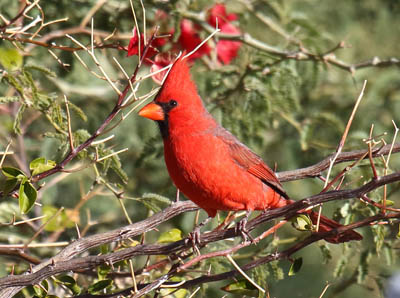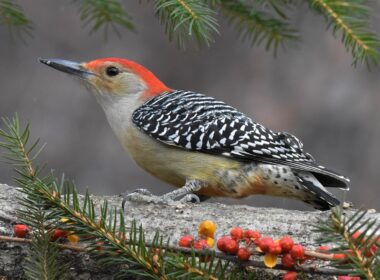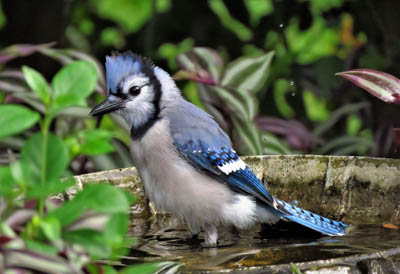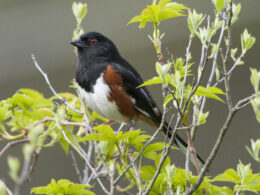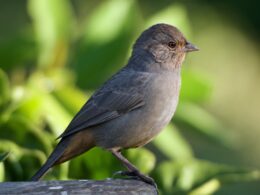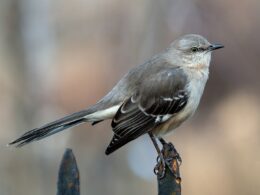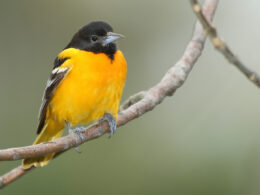Last Updated on January 21, 2024 by Greg Gillson
Did you see a brightly colored red bird, orange bird, or yellow bird in Nebraska and wonder what it was?
This page is for you!
This article shows you photos and identification of some of the most common birds in Nebraska based on color.
The list of birds found in Nebraska includes over 440 species. So, I can’t show you all of them. I’m going to assume that you saw a common bird of this color, but you certainly could have seen something less common, or even rare!
Shape (including the shape of the bill) and size are often more helpful in starting to identify a bird than the color. In fact, most birds in North American can be easily identified with a black-and-white photo!
Many birds are multi-colored, so that it may be hard to pick out a dominant color. Males and females may be colored quite differently. And some color patterns are similar among otherwise dissimilar species.
Nevertheless, I’m going to try to pick out some of the birds that you are most likely to see in backyards or towns. And I’ll show a few others that I get asked about a lot.
The birds with a noticeable amount of red on them in Nebraska covered in this article are:
- American Robin
- Northern Cardinal
- House Finch
- Red-headed Woodpecker
- Rose-breasted Grosbeak
The birds with a noticeable amount of orange on them in Nebraska covered in this article are:
- Barn Swallow
- Baltimore Oriole
- Orchard Oriole
- Brown Thrasher
- American Kestrel
- Red-breasted Nuthatch
- Spotted Towhee
- Ruddy Duck
The birds with a noticeable amount of yellow on them, including lots of yellow and black birds, in Nebraska covered in this article are:
- American Goldfinch
- Northern Flicker
- Western Meadowlark
- Eastern Meadowlark
- Yellow Warbler
- Dickcissel
- Common Yellowthroat
- Western Kingbird
- Cedar Waxwing
- Yellow-rumped Warbler
- Pine Siskin
- Great Crested Flycatcher
- Yellow-headed Blackbird
Red birds of Nebraska
Birds get the red, orange, and yellow in their feathers from carotenoids in the fruit, seeds, and plants they eat (source).
These carotenoid colors combine with melanin to form an infinite range of red feathers–pink, rusty, scarlet, violet, red-orange.
The following are red birds that you are most likely to see in Nebraska.
American Robin
These are familiar lawn birds with red breasts.
 |
| American Robin. Greg Gillson. |
Male American Robins are brownish-gray above with a brick red breast. Females are paler orange below and paler gray above.
They are widespread in open country with scattered deciduous trees, residential areas.
American Robins are year-round residents throughout Nebraska.
Northern Cardinal
These are one of the most common backyard birds in the eastern United States. Their bright red color and unique head profile makes them instantly identifiable to most people–whether they are bird watchers or not!
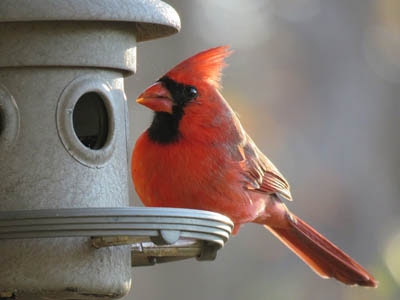 |
| Northern Cardinal. GeorgeB2 from Pixabay. |
Males of these large seed eaters are bright red with a black face and red crest.
Females replace most of the red with brown, The bill is large and orange.
These birds are found in woodlands, stream edges, residential areas.
Northern Cardinals are year-round residents throughout Nebraska.
House Finch
When people ask about a bird with a red head at their feeder, it is usually this bird.
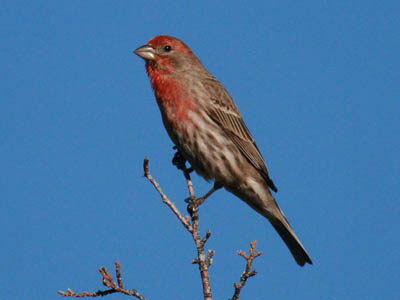 |
| Male House Finch. Greg Gillson. |
Males of this dusty brown striped finch have red limited to the head (specifically the forehead and eyebrow), breast (chest), and rump. The red coloration tends toward orangish and may rarely be yellowish.
Females are streaked, similar to the males but without red. They lack any strong pattern on the face and head.
Note the small round head and curved upper ridge on the bill.
Some people call these red-headed sparrows. Sparrows and finches are similar, but in general, male finches are brighter than the females and tend to hang out more in trees. Sparrow genders are usually quite similar in coloration and tend to feed mostly on the ground.
These birds are common in residential areas, especially at bird feeders. In the West more widespread in arid regions near water.
House Finches are year-round residents in eastern and central and southcentral Nebraska.
Red-headed Woodpecker
These well-known woodpeckers with red heads have a fitting name.
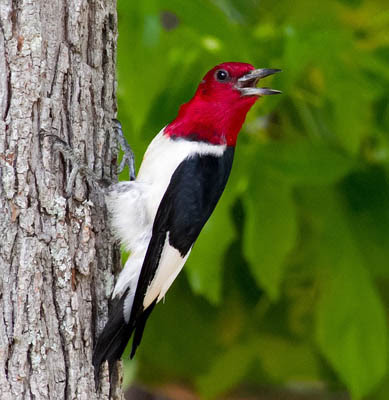 |
| Red-headed Woodpecker. Public domain. |
These birds have the entire head bright deep red. Back and tail black. Underparts white, as are inner secondaries and rump.
They are found in a variety of wooded habitats. They prefer to have oak and beech trees available. Sometimes come to feeders in winter.
Red-headed Woodpeckers are summer residents throughout Nebraska and year-round residents in southeastern Nebraska.
Rose-breasted Grosbeak
These birds with the red breast and huge pink bill sing beautiful robin-like songs from the tops of trees.
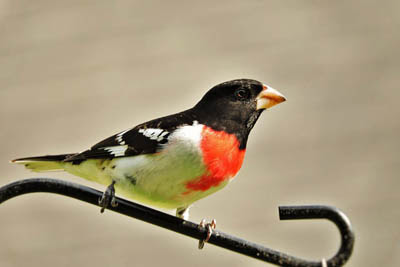 |
| Male Rose-breasted Grosbeak. Susan Killian. Pixabay. |
Males have black hood and upper parts. White under parts. Large white wing patches. Huge pink bill. Inverted bright red triangle on the breast.
Females are brown above, face with broad stripes, white throat. The under parts are buff with many thin brown streaks. Pale bill.
These birds inhabit deciduous and mixed forests. Shade trees in town. Come to feeders.
Rose-breasted Grosbeaks are summer residents in eastern Nebraska and spring and fall migrants throughout.
Orange birds of Nebraska
True orange-colored birds are not that common. Many birds that I have here are paler rusty.
The common pattern is an orange body and black or brown wings and tail. Another common pattern is for the orange to be restricted to the under parts.
The following are orange birds that you are most likely to see in Nebraska.
Barn Swallow
These orange-bellied birds are a familiar sight across North America in summer.
 |
| Barn Swallow. Greg Gillson. |
These birds are purple-blue above with orange under parts and long forked tails. The color of the underparts in winter or on females are often cinnamon or buff-colored, but breeding males can be brighter orange-red.
These birds swoop low over fields and wetlands at lower elevations. They may build their mud nests in rafters on porches, garages, or other out-buildings.
Barn Swallows are summer residents throughout Nebraska.
Baltimore Oriole
These bright orange and black birds are fairly common breeders in wooded areas in the East.
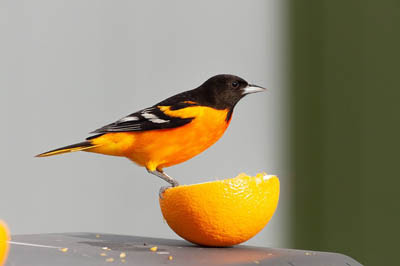 |
| Baltimore Oriole. Michael McGough. Pixabay. |
Males have a black hood and back. Wings black with white patches. Tail black with orange sides to the base. Bright orange under parts.
Females are similar to males, but more olive above, less black. Immature birds for their first year or more are olive above orangish-yellow on the breast, fading to yellow on the belly. Two white wing bars.
These birds are common in deciduous woods, shade trees.
Baltimore Orioles are summer residents throughout most of Nebraska but spring and fall migrants only in southwestern Nebraska.
Orchard Oriole
Males of these orioles are darker rustier-orange than most other orioles in the United States.
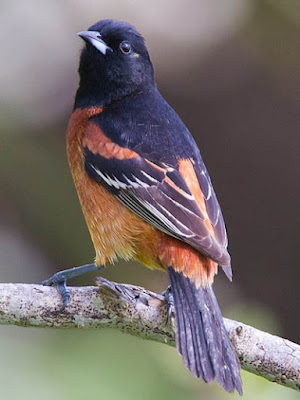 |
| Orchard Oriole. Dan Pancamo. Flikr. CC BY-SA 2.0 |
Males have a black hood and back, black wings and tail. The under parts are rusty-orange or even chestnut-brown.
Females are greenish above, lemon yellow below. They have 2 thin white wing bars. The bill is thinner than many other orioles.
They are found in orchards and residential shade trees.
Orchard Orioles are summer residents throughout Nebraska.
Brown Thrasher
These are rather large rusty-orange songbirds.
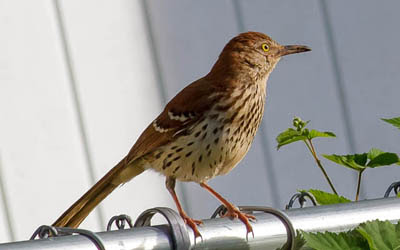 |
| Brown Thrasher. Linda Jones CC0. |
The upper parts of these birds are colored rusty-brown to orange. They show two white wing bars. Under parts are buff with heavy reddish-brown streaking.
These birds live in woodland edges and mature backyard landscaping.
Brown Thrashers are summer residents throughout Nebraska.
American Kestrel
These are the familiar small rusty-orange falcons sitting on power lines on the edge of the highway or hunting and hovering over the median strip.
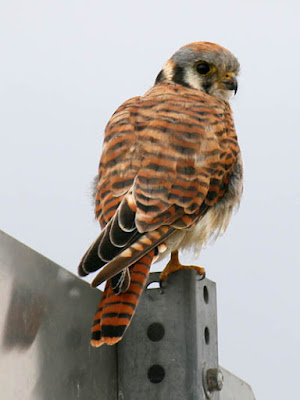 |
| Female American Kestrel. Greg Gillson. |
Females are rusty orange barred with black on their back wings and tail. The under parts are buff with black spots. The head shows two facial stripes.
Males have blue-gray backs and rufous tail is unmarked except for black tail band.
These birds are found in open country, farms, pastures with perches.
American Kestrels are year-round residents throughout Nebraska.
Red-breasted Nuthatch
These active little red-breasted birds crawls all around on the trunk and big branches of conifers. They search crevices in the bark for insect food.
 |
| Red-breasted Nuthatch. Greg Gillson. |
These tiny birds have blue-gray backs and a black line through a white face. Some males can have quite bright rusty red under parts. Some females can have quite pale buff-colored under parts. Most birds show an orange-cinnamon breast color.
Found nearly exclusively in conifers. Readily come to feeders.
Red-breasted Nuthatches are winter visitors throughout Nebraska.
Spotted Towhee
These big sparrows with red sides superficially resemble the coloration of robins.
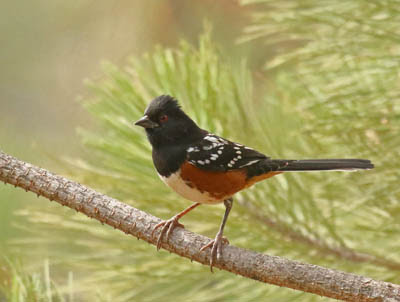 |
| Spotted Towhee. Greg Gillson. |
These birds have dark hoods and upper parts with rusty rufous-red sides and white bellies. They have white spots over their wings, shoulders, and on their tail corners. The upper parts of the males are jet black, females dark brown. Some populations have paler orange sides.
These are somewhat shy birds that hide in the dense brush and spend most of their time on the ground. They visit feeders during quiet periods.
Spotted Towhees are summer residents in parts of southwestern Nebraska.
Ruddy Duck
These small ducks are dark rusty-orange in spring.
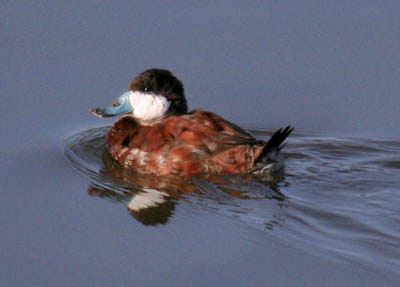 |
| Ruddy Duck. Greg Gillson. |
Males in breeding plumage (late winter and spring) are rusty, with a white face, and a blue bill. The long tail is often held sticking up. In winter they are brown, with white face, and dark bill.
Females all year are like winter males. Brown body, dark cap, dark line through eye of pale face. Dark bill.
These birds prefer weedy ponds to breed, but in winter may be found in deeper ponds in city parks.
Ruddy Ducks are summer residents throughout most of Nebraska, spring and fall migrants only in southeastern Nebraska.
Yellow birds of Nebraska
Yellow is a common bird color! Often it is mixed with black and white plumage in birds.
Many birds with darker upper parts have yellow breast or belly.
The following are yellow birds you are most likely to see in Nebraska.
American Goldfinch
These small little birds are bright yellow and black.
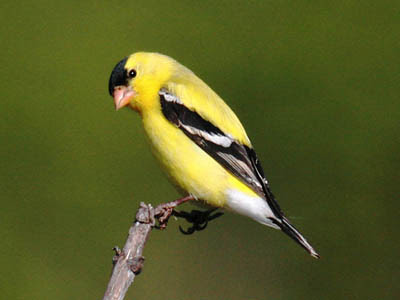 |
| American Goldfinch. Greg Gillson. |
Males are bright lemon yellow with black and white wings and tail, black cap. White under tail coverts. Pink bill.
Females are duller yellow below and brownish above. Lack black cap.
Winter birds are pale brown or gray, a touch of yellow on the throat of males.
These are birds of open country, fields with saplings, clear cuts, residential areas. They avoid dense forests, mountains, deserts. They visit feeders.
American Goldfinches are year-round residents in south and eastern Nebraska, summer residents only in northwestern Nebraska.
Northern Flicker
These woodpeckers spend much time eating ants on the ground.
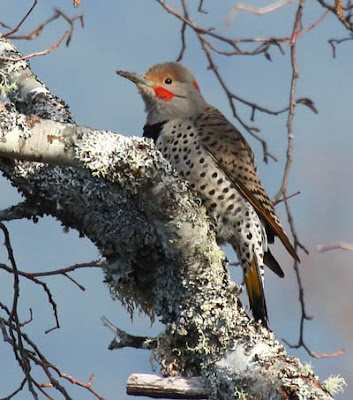 |
| Northern Flicker. Greg Gillson. |
These birds are larger than robins with brown and black barred upper parts. The underparts are pink with round black spots. There is a black crescent across the chest. When they fly away from you, they reveal a large white rump.
Western birds have salmon-red under wings and under tail. Those in the East are colored yellow. The male face differs between the two populations–black whisker on the eastern birds, red whisker on western birds. Intergrades from overlap on Great Plains common. These may show male facial characteristics of both populations, and yellow-orange flight feathers.
These birds live in open woods with bare ground for foraging, residential yards.
Northern Flickers are year-round residents throughout Nebraska.
Western Meadowlark
These are streaky camouflaged prairie birds from above or from behind. But from the front, the breast is shocking yellow!
 |
| Western Meadowlark. Greg Gillson. |
They are streaked brown, black, and gray on the upper parts. The underparts are golden yellow with a black necklace crossing the upper breast. Much paler yellow in fall and winter, as the yellow feathers are tipped with white and streaked with brown.
These are birds of pastures and grasslands and arid regions.
Western Meadowlarks are year-round residents throughout most of Nebraska but winter visitors only in southeastern Nebraska.
Eastern Meadowlark
These pale brown birds with the brilliant yellow breasts are home on the ground in prairies. They sing from perches on isolated trees, power poles, fence posts.
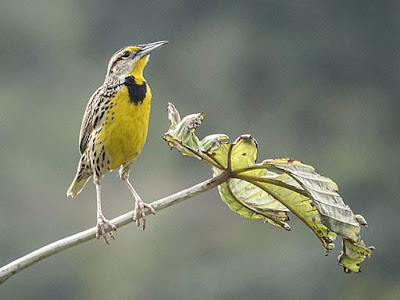 |
|
Eastern Meadowlark
Photo by Mike’s Birds from Riverside, CA, US [CC BY-SA 2.0]
|
The upper parts are streaked black, white, brown, so they blend into the dried grass where they live. The under parts are bright yellow with a black necklace across the chest. Very similar to Western Meadowlark, best told apart by spring song.
These birds live in prairies and extensive pasture lands.
Eastern Meadowlarks are year-round residents in parts of northern, eastern, and central Nebraska.
Yellow Warbler
The golden yellow sun packed all into one little bird! Appears to be an all-yellow bird.
 |
| Yellow Warbler. Greg Gillson. |
Some populations are bright yellow, some tend toward greenish on upper parts, some more golden. Yellow internal tail corners in flight.
Males with red breast streaking, again, variable by population.
Females somewhat to much paler yellow, some greenish, some whitish. Lack red streaks.
These birds are found in willow thickets on the edge of wetlands and ditches, stream sides in arid regions.
Yellow Warblers are summer residents throughout Nebraska.
Dickcissel
These yellow birds often flock together in weedy roadside edges.
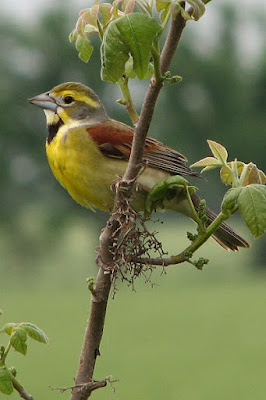 |
| Dickcissel. RebelAT. CC By-SA 3.0 |
These are gray birds with yellow breast and eyebrow.
Males have a black band across the lower throat. They have a large chestnut patch on the shoulder.
Females paler, lack black chest band.
They are found in prairie grasslands and weedy patches.
Dickcissels are summer residents throughout Nebraska.
Common Yellowthroat
These buttery yellow birds are abundant in the marsh vegetation.
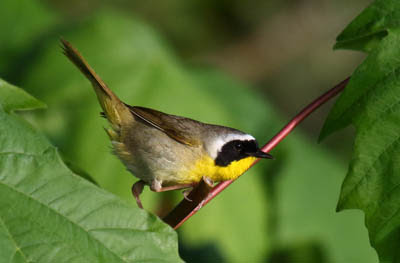 |
| Male Common Yellowthroat. Greg Gillson. |
These skulkers have bright yellow throats and yellow undertail coverts. Males have a black domino mask edged broadly in white, which females lack. Upperparts are dull olive-green.
Immature males in fall show a shadowed black mask.
Found in damp situations and heavy deciduous brambles following clear cuts.
Common Yellowthroats are summer residents throughout Nebraska.
Western Kingbird
These yellow-bellied birds of the prairies often perch on power lines and fence lines.
 |
| Western Kingbird. Greg Gillson. |
These birds are pale gray on the head and breast. Brown wings. The belly is lemon yellow. Black tail has white outer tail feathers, especially obvious in flight.
These are birds of prairies, deserts, pastures, often near water.
Western Kingbirds are summer residents in western and central Nebraska.
Cedar Waxwing
These crested birds with yellow band on the end of the tail are often found in flocks. They eat flying insects in summer, fruit and berries the rest of the year.
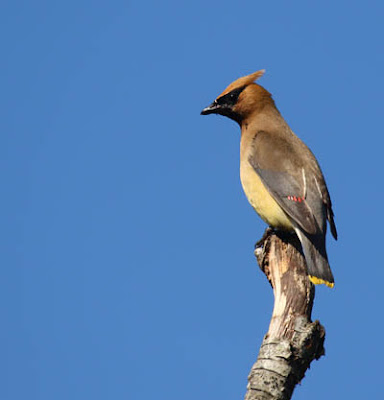 |
| Cedar Waxwing. Greg Gillson. |
These birds are fawn-brown above, with dark gray wings and tail. They have a black mask and wispy crest. The belly is yellow. The wings have waxy red drops on the end of the tertials. The end of the tail has a brilliant yellow tail band.
They are found in open habitats with berries, including juniper woodlands and towns in winter.
Cedar Waxwings are year-round residents throughout Nebraska.
Yellow-rumped Warbler
These are abundant warblers across North America. Affectionately called “butter butts” by many birders, because of their bright yellow rumps that flash in flight.
 |
| Myrtle Yellow-rumped Warbler. Greg Gillson. |
Western form (Audubon’s) with bright yellow throat and yellow rump. Large white wing patch.
Northern and Eastern form (Myrtle) with white throat, yellow rump, and two white wing bars.
Winter birds are dull gray brown, with bright yellow rump. Throat may be cream colored or white. Often difficult to tell the two forms apart in winter.
 |
| Winter Yellow-rumped Warbler. Greg Gillson. |
Breed in mountain or boreal conifers. Widespread in migration. Winter in low river bottoms, open weedy deciduous areas. Rarely come to feeders in winter.
Yellow-rumped Warblers are spring and fall migrants throughout Nebraska.
Pine Siskin
These small brown-streaked birds are relatives of the goldfinches. But you would never know it until they fly and sport yellow wing stripes and tail base. Usually in flocks.
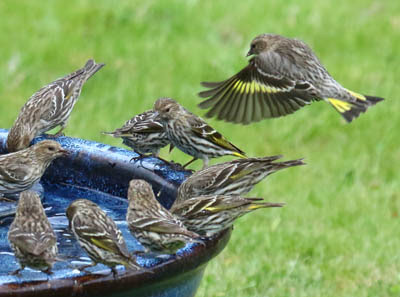 |
| Pine Siskin. Greg Gillson. |
These birds are streaked brown. In flight they have a yellow stripe down the length of the wing. The sides of the base of the tail is also yellow. Some birds are paler, some darker, others brighter yellow, others duller.
These birds are found in summer in northern conifer woods. Irregularly irrupt hundreds of miles southward. Frequent at feeders.
Pine Siskins are winter visitors throughout Nebraska.
Great Crested Flycatcher
These flycatchers have long tails and big heads with big bill and bright yellow belly.
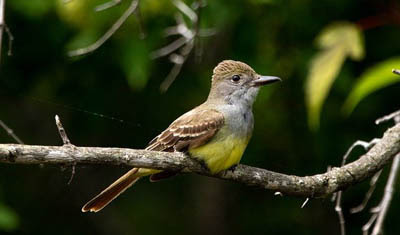 |
| Great Crested Flycatcher. Simard Francois. Pixabay. |
These birds are gray on the face and breast, brownish on rest of upper parts. Bright lemon-yellow belly. The under side of the tail and some feathers of the wing is cinnamon colored.
These birds stay in the canopy of open woods.
Great Crested Flycatchers are summer residents in central and eastern Nebraska.
Yellow-headed Blackbird
These blackbirds with yellow heads are found in marshes in the West.
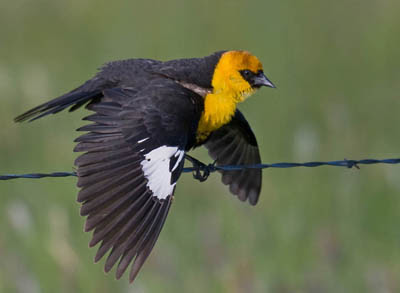 |
| Yellow-headed Blackbird. Greg Gillson. |
Males are glossy black with bright golden-yellow head and breast. White wing patches.
Females are duller brown with mottled yellow breast.
These birds nest in cattail marshes in prairies. Winter in large flocks in agricultural areas.
Yellow-headed Blackbirds are summer residents throughout Nebraska.
Wrapping Up
Nebraska boasts a diverse array of feathered friends, some sporting truly stunning plumage. Here are some of the other colorful birds you might encounter in the state:
- Western Tanager: These vibrant songbirds arrive in spring, bringing a splash of color with their bright yellow bodies, black wings, and red heads (males). Look for them in open woodlands, edges of forests, and parks.
- Painted Bunting: Another stunner, males dazzle with a kaleidoscope of colors – turquoise head, red breast, green back, and purple wing bars. Females are more subtly colored but still beautiful. Find them in open grasslands, brushy fields, and edges of woodlands.
- Lazuli Bunting: A charming smaller bluebird, males sport a bright blue head and breast, white wing bars, and chestnut back. They prefer open fields, meadows, and edges of woodlands.
- Summer Tanager: This vibrant songbird flaunts a deep rose-red body, black wings, and a yellow wing bar (males). Look for them in mature deciduous forests and edges of woodlands.
Frequently Asked Questions
Where can I find meadowlarks in Nebraska?
Finding meadowlarks in Nebraska depends on which species you’re hoping to see, as both types occur in the state:
Western Meadowlark:
- Abundant: This is the more common of the two meadowlarks in Nebraska, found almost statewide during the spring and summer months. You can spot them in a variety of habitats, including:
- Grasslands: Tall and mixed-grass prairies, hayfields, wet meadows, and edges of croplands.
- Agricultural landscapes: They readily adapt to farmlands, often seen along field edges and roadsides.
- Open areas: Look for them in parks, golf courses, and even backyards with sufficient open space.
Eastern Meadowlark:
- Less common: Found primarily in the southeastern corner of Nebraska, with smaller populations in the eastern fringes of the Sandhills. They prefer similar habitats to the Western Meadowlark but occur in lower densities.
- Specific areas: Look for them in wet meadows, pastures, prairie remnants, and other grasslands in counties like Lancaster, Gage, Pawnee, and Richardson.
What is the rust colored bird in Nebraska?
Several rust-colored birds could be found in Nebraska, depending on the shade of rust and other features you observed. Here are some possibilities:
Summer Visitors:
- Song Sparrow: These common birds have brown streaks on their back and chest, with a central reddish brown breast spot. They prefer open fields, brushy areas, and edges of woodlands.
- Chipping Sparrow: These small sparrows have a rusty crown and gray head, along with streaked brown plumage. They frequent backyards, parks, and open woodlands.
- Clay-colored Sparrow: This ground-dwelling sparrow has a reddish brown head and streaked brown body. Look for them in dry grasslands and open fields.
Year-round Residents:
- American Robin: These familiar thrushes have a beautiful rusty orange breast and dark head and back. They are common in a variety of habitats, including woodlands, parks, and backyards.
- Cedar Waxwing: While not solely rust-colored, these birds have reddish brown wing feathers, yellow flanks, and a black mask (males). They frequent woodlands, parks, and orchards.
- Red-breasted Nuthatch: These acrobatic climbers have a rusty brown breast and back, along with a black eye stripe and white belly. They inhabit coniferous and mixed forests.
What bird has red on the back of its head in Nebraska?
The Downy Woodpecker is definitely found in Nebraska. In fact, it’s one of the most common and widespread woodpeckers in the state. They are year-round residents, meaning you can encounter them throughout the year in a variety of habitats.
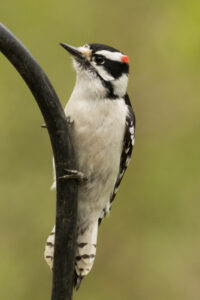
Here’s what to know about Downy Woodpeckers in Nebraska:
- Habitat: They prefer open woodlands, parks, orchards, and even backyards with mature trees.
- Appearance: These small woodpeckers have a black-and-white pattern with a white belly, black forehead and crown, and a white stripe down the back. Males have a small red patch on the nape of their neck.
- Behavior: They forage for insects by tapping on tree trunks and branches, often excavating small holes to reach prey. They also readily visit feeders offering suet and sunflower seeds.
- Sound: Their call is a high-pitched “pik” or “drumming” sound made by rapidly tapping on wood.
Related Articles:
See photos and learn about the most common backyard birds in Nebraska, regardless of color.
Birds at your feeder in Nebraska
Here’s a quick tutorial of how I would teach you to identify birds: 7 Steps to Identify Birds!
Birds with red heads in North America.
Yellow-and-black birds in North America.



